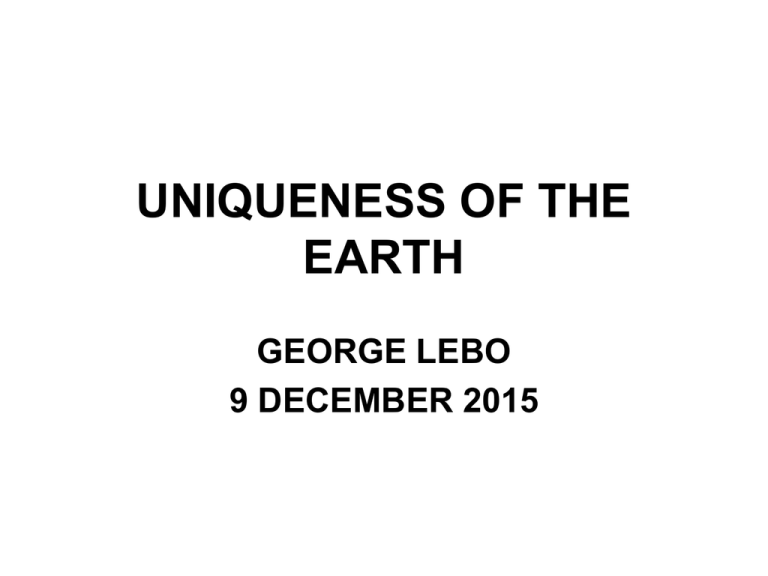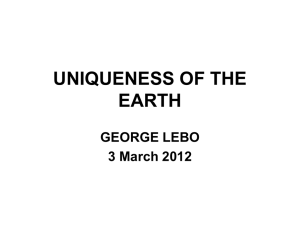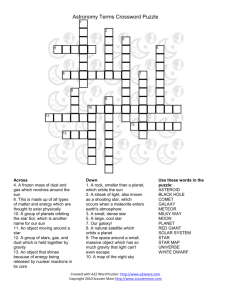UNIQUENESS OF THE EARTH GEORGE LEBO 9 DECEMBER 2015
advertisement

UNIQUENESS OF THE EARTH GEORGE LEBO 9 DECEMBER 2015 LOCATION THE RIGHT GALAXY CLUSTER Can’t be in a rich cluster: Mergers and collisions will be too frequent Must have nearby dwarf galaxies to supply gas and dust that maintains the Milky Way’s spiral structure The Local Group Within 500,000 Light Years The Local Group Within 5 Million Light Years LOCATION THE RIGHT GALAXY TYPE Must be a spiral galaxy: only 5% are spiral, the rest are elliptical or irregular Elliptical galaxies have no dust and gas, hence no heavy elements out of which to make life supporting planets. Large irregular galaxies have active nuclei whose radiation would exterminate life. Small irregular galaxies have insufficient heavy elements to support life. LOCATION RIGHT LOCATION IN THE GALAXY Must be near, but not in, a spiral arm. We are at a corotation point far from our galactic center. Note: At the co-rotation point the Sun remains stationary and out of a spiral arm. Most all stars in the Milky Way are in the central bulge, a globular cluster or a spiral arm. In each of these locations the star densities are too high – the planetary orbits would be unstable. THE RIGHT STAR Must be one and only one star – Gravity from two or more stars would make stable planetary orbits impossible. If no star (planet was thrown out of planetary system) there would be no energy source. Must be a G-type star: If hotter, UV would extinguish life: If cooler, would have to be so close that tidal effects of the star on the planet would slow the planet’s rotation. THE RIGHT PLANET • MUST BE IN THE HABITABLE ZONE (Water at the triple point), distance within 2% • MUST HAVE THE RIGHT SURFACE GRAVITY – If too high, hydrogen and helium would be retained – If too low, the atmosphere would dissipate into space (within 2%) • MUST HAVE THE RIGHT ROTATIONAL PERIOD – If too fast, circulational weather pattern would be too severe – If too slow, the day/night temperature variation would be too great • MUST HAVE A MAGNETIC FIELD – Needed for protection from the Solar wind • MUST HAVE A CENTRAL HEAT SOURCE (AN UNUSUALLY LARGE CORE) TO DRIVE TECTONIC ACTIVITY – The Earth’s surface would erode to the extent that life would not survive unless the Earth’s crust was constantly replenished. • MUST HAVE WATER (OR SOME OTHER LIQUID) – To lubricate the tectonic activity THE RIGHT PLANETARY COMPANIONS • NEED A GIANT OUTER PLANET LIKE JUPITER – It takes the hit from asteroids and comets eliminating catastrophes on Earth • NEED A LARGE MOON IN ORDER TO: Stabilize the Earth’s axial tilt Create tides which wash the Earth’s surface cleansing the oceans and mixing oxygen from the air into the water to support marine life. SHORT LIST OF EARTH’S UNIQUE PARAMETERS • • • • • • • • • • • • • • • GALAXY CLUSTER TYPE GALAXY SIZE GALAXY TYPE GALAXY LOCATION PARENT STAR’S DISTANCE FROM GALACTIC CENTER PARENT STAR’S DISTANCE FROM CLOSEST SPIRAL ARM NUMBER OF STARS IN PLANETARY SYSTEM PARENT STAR BIRTH DATE PARENT STAR AGE PARENT STAR MASS PARENT STAR METALLICITY (HEAVY ELEMENTS) PARENT STAR COLOR ESCAPE VELOCITY DISTANCE FROM PARENT STAR ORBITAL ECCENTRICITY • • • • • • • • • • • • • • • • • • AXIAL TILT ROTATION PERIOD MAGNETIC FIELD ALBEDO MASS OF “GREAT COLLIDER” TIMING OF “GREAT COLLIDER” SPEED OF “GREAT COLLIDER” COLLISION ANGLE OF “GREAT COLLIDER” CO2 LEVEL IN ATMOSPHERE O2 QUANTITY IN ATMOSPHERE H20 LEVEL IN ATMOSPHERE O3 LEVEL IN ATMOSPHERE SEISMIC ACTIVITY GRAVITATIONAL INTERACTION WITH MOON JUPITER DISTANCE JUPITER MASS ATMOSPHERIC PRESSURE ATMOSPHERIC TRANSPARENCY SUMMARY • EARTH HAS SOME UNIQUE CHARACTERISTICS • HUGH ROSS LISTS 322 SUCH PARAMETERS • HE PLACES A PROBABILITY OF -304 APPROXIMATELY ONE IN 10 IN FINDING ANOTHER PLANET LIKE EARTH IN THE 22 UNIVERSE IF THERE ARE 10 PLANETS (ONE PER STAR) • http://www.reasons.org/articles/probabilityfor-life-on-earth-apr-2004 • ADMITEDLY THIS IS ROSS’ OPINION ANTHROPIC COSMOLOGICAL PRINCIPLE THE UNIVERSE APPEARS THAT IT IS “DESIGNED” SO THAT HUMAN LIFE CAN EXIST



